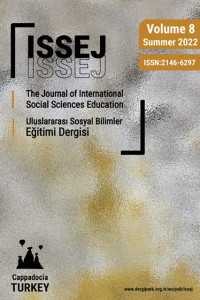İlköğretim Altıncı Sınıf Öğrencilerinin Sel Kavramıyla İlgili Kavram Yanılgıları
Araştırmanın amacı, ilköğretim okulları müfredatından seçilmiş doğal afet kavramı olan: Sel ile ilgili konulardaformal eğitim almış ilköğretim 6. sınıf öğrencilerinin bu kavramları anlama düzeylerini ve bu kavramlara ilişkinyanılgılarını tespit etmektir.Bu araştırmada nicel araştırma yöntemleri kullanılmıştır. Coğrafya'da doğal afetler eğitiminin öğrencilertarafından anlaşılma düzeyini tespit etmek için pilot çalışma yardımıyla bir anket geliştirilmiştir. Bu ankette yeralan sorular, açık uçlu ve öğrencilerin araştırılan konu ile ilgili bilgilerini tam olarak aktarmalarını sağlayacakşekilde hazırlanmıştır. Hazırlanan bu anket Ordu iline bağlı Gürgentepe ilçesinde bulunan dört ilköğretimokulunun 11–12 yaş grubunda olan altıncı sınıf öğrencileri arasından şans yöntemiyle seçilen yüz öğrenciyeuygulanmıştır.Araştırma sonunda öğrencilerin söz konusu doğal afetlerle ilgili sel kavramı anlama düzeyleri, doğal afetlerinoluşumunu, meydana getirdikleri zararlar ve bu zararlardan korunma yollan konusunda yeterli bilgi düzeyinesahip olmadıkları ortaya çıkarılmıştır. Ayrıca öğrencilerin doğal afetlerle ilgili sel kavramını yeterli düzeydeanlayamadıkları ve bu kavrama ilişkin önemli yanılgılarının olduğu tespit edilmiştir.Araştırmanın sonucunda öğretim programında doğal afetlerle ilgili konuların öğretiminde yeterli başarısağlanamadığı görüldüğünden doğal afetlerin eğitimi ve öğretimine ilişkin öğretmenlere ve uzmanlaratavsiyelerde bulunulmuştur.
Anahtar Kelimeler:
Soysal bilgiler öğretimi, doğal afetler, doğal afetler eğitimi, sel, kavram yanılgısı
Sixth Grade Primary School Students’ Misconceptions About Flood
The aim of this research is to determine the comprehension level and to highlight any misunderstandings,covering the concepts of natural disasters including floods amongst grade 6 primary school students who haveundertaken formal education as set in the school curriculum.Quantitative methods have been applied during the research. With the aid of a pilot study, a questionnaire hasbeen developed to determine how well students in geography class have understood the topic of naturaldisasters. The questions in the questionnaire are open ended and have been designed to enable the students towrite as much as they know about the research topic. The prepared questionnaire has been filled out by 100students in grade 6, aged between 11-12 years old, who have been randomly selected from 4 different schools inGûrgentepe, a country of the province of Ordu.Upon the completion of the research it was discovered that the concepts covering the topic of natural disasters,why and how natural disaster occurs, the losses they bring along and how to protect against them were notsufficiently understood amongst the students. Furthermore, it was established that the students had inadequateinformation and could not fully understand the concepts of natural disasters, it was predicted that many hadinfact, misunderstandings about the issues.This research concludes that although the school curriculum has newly added the topic of naturaldisasters, it is recommended to teachers and specialists who prepare the school curriculum toremember that this topic has been issued and educated without success.
Keywords:
Social science teaching, natural disasters, education in natural disasters, floods, misunderstood concepts,
___
- Akbaş, Y., İlköğretim 6. Sınıf Öğrencilerinin Coğrafi Kavramları Anlama Düzeyleri ve Kavram Yanılgıları,
- Karadeniz Teknik Üniversitesi Sosyal Bilimler Enstitüsü, Yayınlanmamış Yüksek Lisans
- Tezi, Trabzon, 2002.
- Coştu, B., Lise I Öğrencilerinin Buharlaşma, Yoğunlaşma ve Kaynama Kavramlarını Anlama Seviyeleri, Yeni
- Bin Yılın Başında Türkiye'de Fen Bilimleri Sempozyumu, İstanbul, 7-8 Eylül 2001.
- Cin, M., The Influence of Direct Experience of the Physical Environment on Concept Learning in Physical
- Geography, E.D Thesis, School of Education, Durham, 1999
- Çepni, S., Araştırma ve Proje Çalışmalarına Giriş, Erol Ofset, Trabzon, 2001.
- Driver, R., Students' Conceptions and the Learning of Science", International Journal Science Education, Vol.
- 11 (Special Issue 1989), pp. 481-490.
- Harwood, D., Jackson, P. Why Did They Build This Hill so Steep? Problems of Assessing Primary Children's
- Understanding of Physical Landscape Features in the Contexs of the UK National Curriculum,
- Geographic and Environmental Education, Vol:2, No:2 (1993), pp. 64-79.
- Jahoda, G., The Development of Children's Ideas About Country and Nationality, British Journal of
- Educational Psychology, 33 (1963), pp.47-60.
- Kaptan, S., Bilimsel Araştırma ve İstatistik Teknikleri, Tekışık Web Ofset Tesisleri, Ankara, 1993.
- Kırcaali-İftar, G., Sosyal Bilimlerde Araştırma Yöntemleri, Anadolu Üniversitesi Açıköğretim Fakültesi
- Yayınları, No: 601, Eskişehir, 1999.
- Lıdstone , J., Tnternational Persectives on Teaching about Hazard and Disasters, Channel Wiew Publication,
- Clevedon BS21 7SJ, England, 1996.
- Pıaget, J., The Child's Conception of the World, Routledge and KeganPaul, London, 1929.
- Platten, L., Talking Geography: an Investigation into Young Children's Understanding of Geographical Terms
- Part-1, International Journal of Early Years Education,Vol.3, Number.T (Spring 1995a),
- pp.74-91.
- Quintero, Ileana M., Understanding Children's Conceptions of Geographical Space, a Thesis Presented to
- He Faculty of the Graduate School of Education of Harvard University in Partial
- Fulfillment of the Requirements for the Degree of Doctor of Education, 1996.
- Şahin, C., Türkiye Afetler Coğrafyası, Gündüz Eğitim Yayıncılık Ankara, 1991.
- Sheridan, Jack M.. Children's Awareness of Physical Geography, The Journal of Geography, 67 (1968), pp.
- 82-86.
- Başlangıç: 2011
- Yayıncı: Abdulkadir UZUNÖZ
